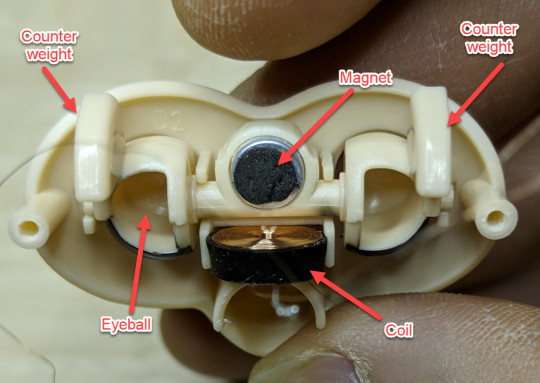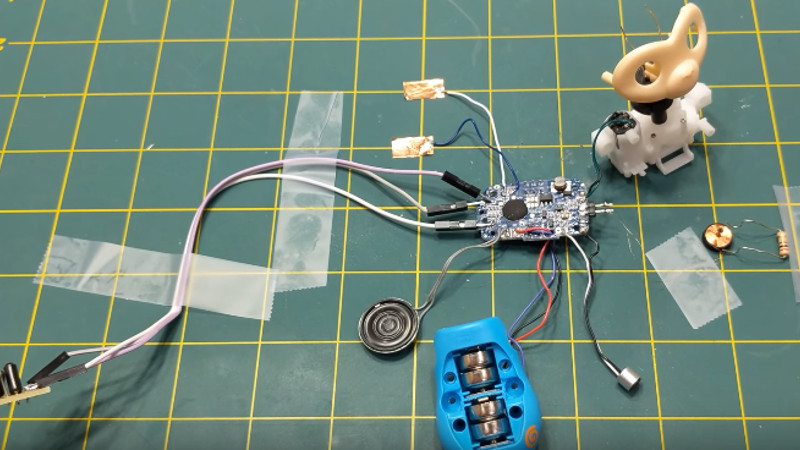Due to the graphic nature of this post, small children and the elderly may want to leave the room. One of the hottest toys this holiday season has been gutted like a fish so that we may better understand the nature of its existence. Or maybe just what kind of sensors and motors the craftsmen over at WowWee managed to cram into a “robot” with an MSRP of only $15 USD.
[Josh Levine] mercilessly tears a Fingerling Monkey limb from limb on his blog, and points out some interesting design decisions made. While some elements of the toy are rather clever, there’s a few head-scratchers to be had inside the Fingerling. It’s interesting to see the final results of a decision process that had to balance the relatively rough life such a toy will live with the ever crucial cost of production.
 The eyelids are particularly well thought out, operated by charging a coil under a magnet which is embedded in the plastic. Opening and closing the eyelids without a separate motor or gearbox is not only easier and cheaper, but prevents the possibility of damage if a child attempts to force open the eyes or otherwise manipulate the mechanism.
The eyelids are particularly well thought out, operated by charging a coil under a magnet which is embedded in the plastic. Opening and closing the eyelids without a separate motor or gearbox is not only easier and cheaper, but prevents the possibility of damage if a child attempts to force open the eyes or otherwise manipulate the mechanism.
Other cost saving measures include the use of foil tape as a capacitive sensor, and simple ball-filled tilt sensors to detect orientation rather than an expensive accelerometer.
Interestingly, other parts of the toy seem overengineered in comparison. A cam and limit switch are used to detect when the Fingerling’s head has turned to its maximum angle, when it would have been cheaper and easier to simply detect motor stall current.
If you’re interested in seeing what makes popular toys tick, we’ve got a number of plaything tear downs which are sure to keep you satiated until the next big holiday toy rolls around.
















I knew that you could charge a capacitor, but I was not aware that you could charge a coil.
http://ieeexplore.ieee.org/document/602562/
If by charging we understand storing energy, then yes, a coil can store energy (in magnetic field) the same as a capacitor can store energy (in electric field).
Just watched the video, there is no “charging a coil” there.
It’s rather about energizing a coil in order to use it together with a small magnet as a mechanical actuator.
oddly missing: what the damned thing looks like BEFORE you tore it apart. this and the article both fail to show what the ‘before’ shot was. odd.
…terrifying
https://www.fingerlings.com/
Reminds me of the needy furby that started screeching when it got too little attention.
Yeah.. I had the exact same thing.. WTH is a fingerling anyway? Some of us don’t live in the US.
And some of us that do live in the US have never seen one of those stupid things.
Why are they called fart monkeys?
https://www.youtube.com/watch?v=hO__Czigu_Y
I’m petty sure you can guess why…
Aw yuck! Thats sick.
I was really hoping “Fart Monkey” was an official term for them so I would have an excuse to use it in the headline, but alas it seems not.
So 2017 is now the year of the fart monkey.
Sums it up nicely.
Wake me up when it’s 2018.
!RemindMe 13 Hours
IT is … … …. …. …
Motor stall current… That seems a bit naive. As this is a mass production item and current is going to be all over the place for these cheap motors. also stalling is bad… Why even do that when you can just stop at the correct position.
I wouldn’t be surprised if they actually tested using stall current and found that it both decreased battery life as well as reliability.
I was going to say something similar. When you hit the stall current, you only know that you’ve hit the current threshold. You can only assume that you’ve turned the head to the maximum angle.
Maybe you’ve just encountered a little brother’s attempt at twisting the head off.
+1 for little brothers!
If you read the source page, that’s exactly the point [Josh] makes. If you used motor stall current you’d be able to turn off motor when a kid was trying to twist the head or otherwise mess with its normal operation rather than grinding gears because it’s not seeing the endstop switch close.
My question is: did the design team allow these things in their homes?
And – how does it know you are blowing on it? I assume the mic, but is it really picking up the air being blown on the mic? Seems the sound of the user blowing is too faint.